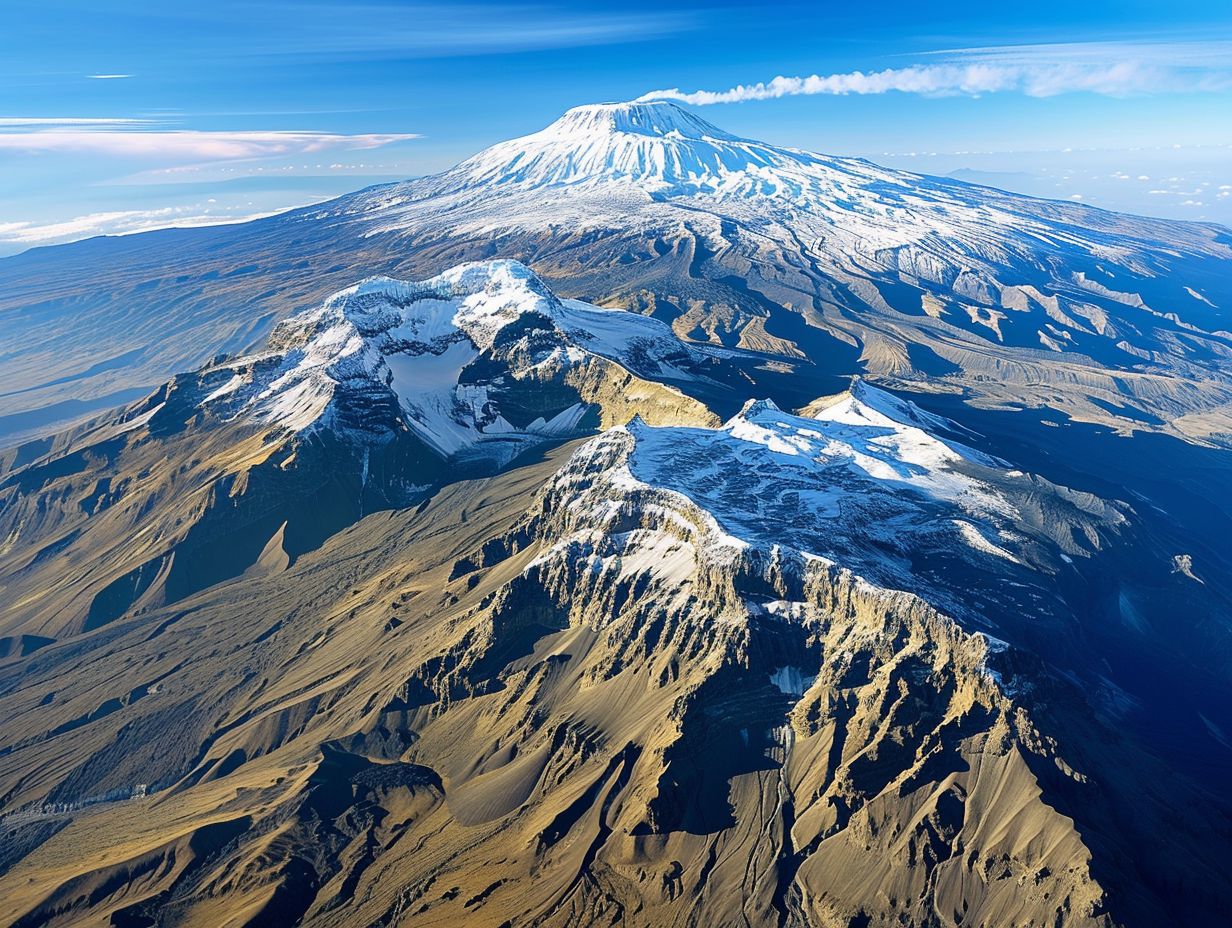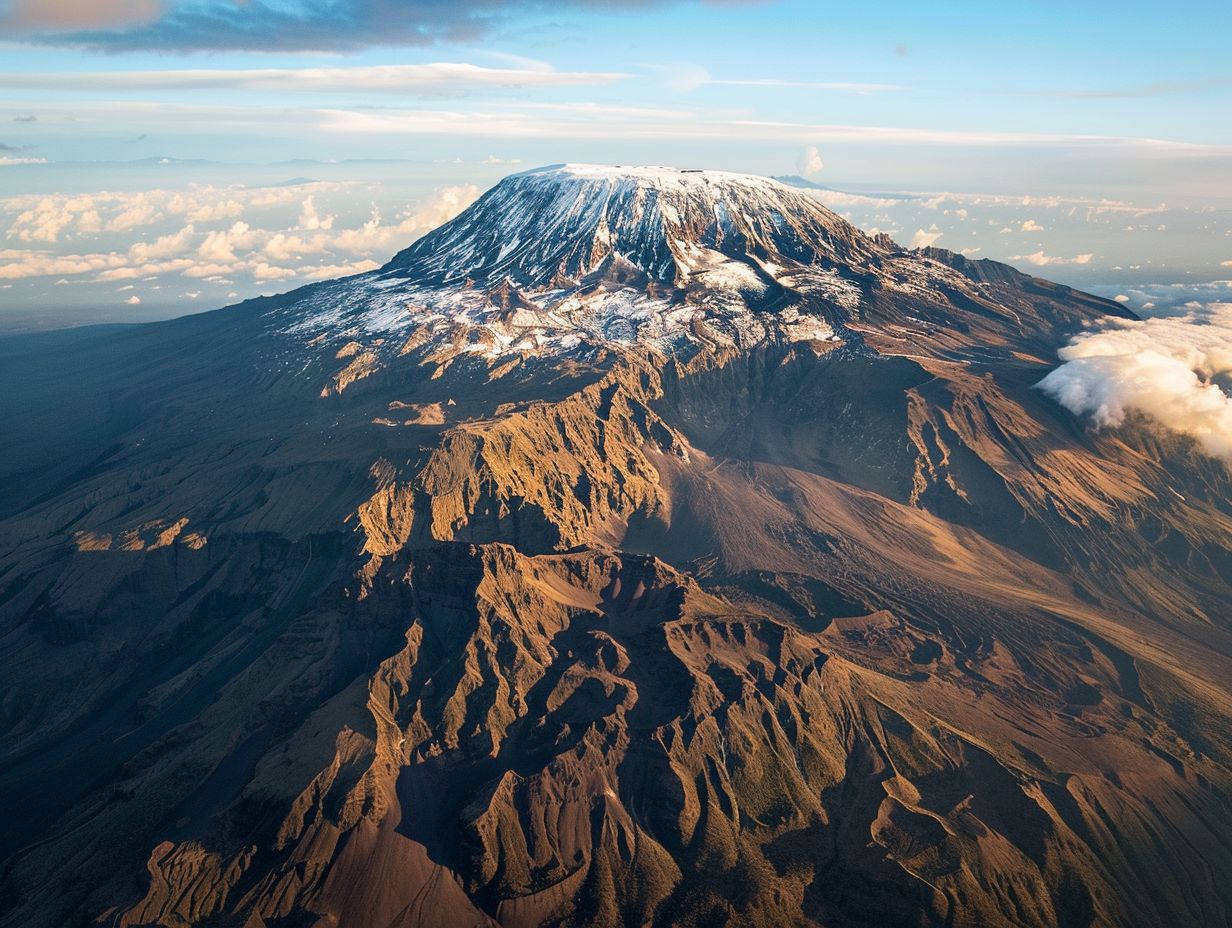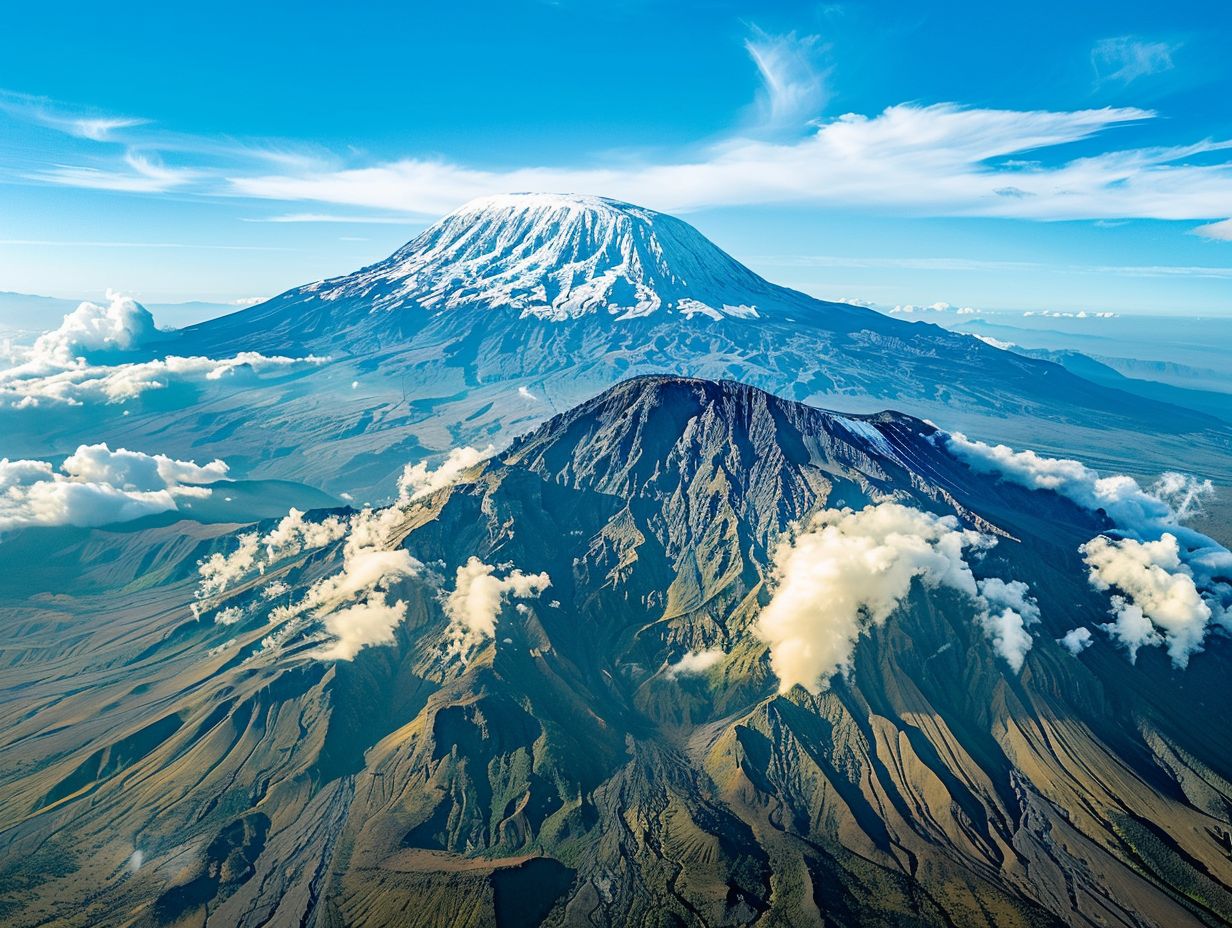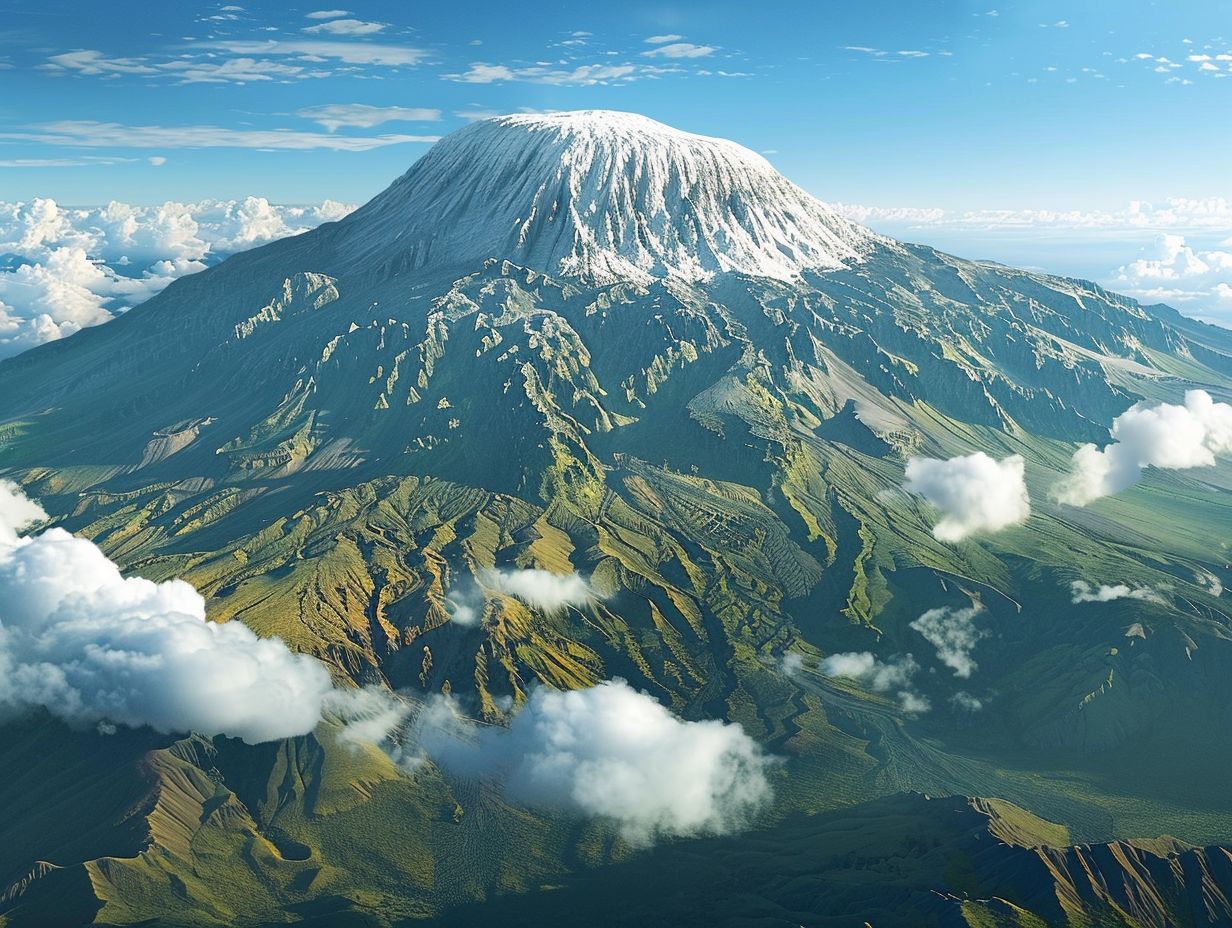
Mount Kilimanjaro, the highest mountain in Africa, is home to three prominent volcanic cones – Kibo, Mawenzi, and Shira.
We will explore how these cones were formed, their unique characteristics, and the differences between them in terms of size, shape, age, and elevation.
Discover how these volcanic cones contribute to the beauty and biodiversity of Mount Kilimanjaro, as well as the potential dangers hikers may face while exploring these natural wonders.
Key Takeaways:

- The Mount Kilimanjaro volcanic cones, namely Kibo, Mawenzi, and Shira, contribute to the mountain’s unique beauty and biodiversity.
- Each volcanic cone has its own characteristics, such as size, shape, and age, that make them distinct from one another.
- Hiking on these volcanic cones can be dangerous due to potential altitude sickness, volcanic activity, and harsh weather conditions.
What Are the Volcanic Cones of Mount Kilimanjaro?
Mount Kilimanjaro consists of three main volcanic cones: Kibo, Mawenzi, and Shira, each contributing to the mountain’s diverse geological features.
Kibo is the highest and most well-known among the three cones, characterized by its jagged peak and massive crater. Mawenzi, the second highest cone, is distinguished by its rugged, rocky terrain and sharp pinnacles. Shira, the oldest cone, is known for its wide plateau and gentle slopes. These cones collectively showcase the complex geological history of Mount Kilimanjaro, with each one representing different stages of volcanic activity and erosion over millions of years.
Kibo
Kibo, the largest of Mount Kilimanjaro’s volcanic cones, is characterized by its summit crater, remnants of glaciers, ancient lava flows, and unique geological features.
Kibo’s summit crater, named Uhuru Peak, stands as the highest point in Africa at 5,895 meters. The glaciers on Kibo, such as the Furtwängler Glacier, are iconic but sadly receding due to climate change.
Over the centuries, Kibo has witnessed numerous lava flows that have shaped its rugged landscape, creating striking contrasts between old and new formations. The ash pits and cones scattered across Kibo’s surface are evidence of its explosive past, offering a glimpse into its volcanic history.
Mawenzi
Mawenzi, a secondary volcanic cone of Mount Kilimanjaro, exhibits signs of past volcanic activity, frequent rockfall, seismic activity, and a distinct summit crater.
These geological characteristics showcase the dynamic nature of Mawenzi’s formation. The cone is a remnant of ancient volcanic eruptions that sculpted the landscape over time. Due to the erosion caused by weathering and tectonic forces, rockfall is a common occurrence on its steep slopes, contributing to the ever-evolving terrain.
Seismic activity in the region indicates the continued geologic activity beneath the surface. The formation of the summit crater, a result of past eruptions and subsequent erosion, adds a unique feature to Mawenzi’s geological profile, offering a window into its fiery past.
Shira
Shira, one of the volcanic cones of Mount Kilimanjaro, is notable for its expansive ice fields, glacier formations, ongoing geological processes, and environmental impact.
These ice fields, in particular, contribute significantly to the unique landscape of Shira. The glaciers, such as Furtwängler Glacier, not only add to its visual appeal but also play a crucial role in the area’s ecosystem and hydrology.
The geological processes shaping Shira are fascinating; the cone itself formed through a series of volcanic activities over time. This dynamic history is evident in the various rock formations and lava flows found within the region.
How Were These Volcanic Cones Formed?
The formation of the volcanic cones on Mount Kilimanjaro is a result of complex geological processes over time, involving various eruption events and geological entities.
Mount Kilimanjaro, located in Tanzania, is an iconic volcanic mountain with three main volcanic cones: Kibo, Mawenzi, and Shira. These cones were formed through a series of volcanic eruptions that occurred over millions of years, shaping the landscape as we see it today.
Volcanic eruptions from the Earth’s mantle caused molten rock, ash, and gas to rise to the surface, building up the cones layer by layer. The pressure and heat generated by these eruptions played a crucial role in shaping the volcanic features of the mountain.
What Are the Characteristics of Each Volcanic Cone?

Each of the volcanic cones of Mount Kilimanjaro, namely Kibo, Mawenzi, and Shira, possesses unique characteristics that define their geological significance.
Kibo, the highest and most prominent of the three cones, is typically covered in snow and ice due to its peak elevation. Mawenzi, known for its jagged peaks and rugged terrain, offers a challenging climb for experienced mountaineers. In contrast, Shira is a dormant cone characterized by its wide plateau and gentle slopes
These distinct features contribute to the diverse landscape of Mount Kilimanjaro, showcasing a blend of rocky outcrops, glaciers, and lush vegetation. Kibo’s summit, Uhuru Peak, is the main goal for many climbers, while Mawenzi and Shira provide stunning views and opportunities for exploration
What Are the Differences Between the Volcanic Cones?
The volcanic cones of Mount Kilimanjaro, Kibo, Mawenzi, and Shira, exhibit variations in size, shape, and age, contributing to the mountain’s diverse landscape.
Among the three volcanic cones of Mount Kilimanjaro, Kibo is the largest and tallest, dominating the skyline with its impressive height. Mawenzi, on the other hand, is characterized by its jagged peaks and rugged terrain, presenting a stark contrast to the smooth slopes of Kibo.
Shira, the oldest of the three cones, features a collapsed caldera that has evolved into a high plateau, offering expansive views of the surrounding landscape.
These distinct characteristics of Kibo, Mawenzi, and Shira shape the overall topography of Mount Kilimanjaro, creating a unique and captivating environment for climbers and adventurers alike.
How Do These Volcanic Cones Contribute to Mount Kilimanjaro’s Beauty and Biodiversity?
The volcanic cones of Mount Kilimanjaro play a crucial role in enhancing the mountain’s beauty and fostering diverse ecosystems that support rich biodiversity.
These cones not only add to the majestic and dramatic landscapes of Kilimanjaro but also provide unique habitats for a wide range of plant and animal species. The varying microclimates created by the cones offer different niches for vegetation to thrive, contributing to the overall ecological richness of the region.
Mount Kilimanjaro’s volcanic cones act as natural barriers, influencing the distribution of flora and fauna across the mountain, leading to the evolution of endemic species. The diverse ecosystems supported by these cones are teeming with life, from lush forests on lower slopes to sparse vegetation at higher altitudes, showcasing the adaptability of organisms to extreme conditions.
What Are the Dangers of Hiking on These Volcanic Cones?
Exploring the volcanic cones of Mount Kilimanjaro comes with inherent risks, including altitude sickness, volcanic activity, and exposure to harsh weather conditions.
Altitude sickness is a common concern for hikers due to the rapid elevation gain on the mountain, leading to symptoms like headaches, dizziness, and nausea. The threat of volcanic activity, although rare, adds another layer of danger, with potential hazards such as lava flows or ash clouds.
Severe weather conditions, such as sudden storms or extreme cold, can pose significant risks to hikers, making proper preparation and caution essential for those brave enough to tackle this magnificent yet perilous landscape.
Altitude Sickness
Altitude sickness poses a significant risk for hikers on Mount Kilimanjaro, especially as they ascend towards the summit, affecting their overall well-being and safety.
As hikers climb to higher altitudes, the decrease in oxygen levels can result in a range of symptoms such as headaches, nausea, dizziness, and fatigue. Altitude sickness can progress to more severe forms like high altitude pulmonary edema (HAPE) or high altitude cerebral edema (HACE), which can be life-threatening if not treated promptly.
Recognising the signs of altitude sickness early, such as difficulty breathing or confusion, is crucial for hikers’ safety. Proper acclimatization, hydration, and a gradual ascent are key strategies to prevent altitude sickness and ensure a successful trek to the summit.
Volcanic Activity
The potential for volcanic activity on Mount Kilimanjaro poses hazards for hikers, with the history of past eruptions highlighting the need for caution and preparedness.
Mount Kilimanjaro, a dormant stratovolcano, has had several notable eruptions in the past, causing concern for those exploring its majestic slopes. The key hazards faced by hikers include potential ash clouds, lava flows, and gas emissions, which can pose serious risks to human life and disrupt hiking expeditions.
Safety measures such as monitoring systems, evacuation plans, and proper guidance become crucial in mitigating these dangers and ensuring the well-being of climbers. Understanding the geological factors that influence volcanic activity is essential for expedition leaders to make informed decisions and safeguard the participants during their journey.
Harsh Weather Conditions
The unpredictable and harsh weather conditions on Mount Kilimanjaro present hazards for hikers, exacerbated by the effects of climate change on the mountain’s climate patterns.
Hikers attempting to conquer the majestic peak of Mount Kilimanjaro must navigate through a myriad of weather challenges ranging from icy winds to sudden rainstorms.
The impacts of climate change have introduced a new level of uncertainty, disrupting the traditional weather patterns that once guided climbers. As temperatures shift and weather extremes become more common, the need for meticulous safety precautions becomes paramount.
Guides now have to factor in rapid changes in conditions and be equipped to handle emergency situations with agility and expertise. The once familiar landscapes are evolving, with glaciers receding and snow cover diminishing, altering the terrain and posing fresh obstacles for adventurers.
What Are the Geological Features of Mount Kilimanjaro?

Mount Kilimanjaro boasts distinctive geological features such as an ice cap, stratovolcano structure, ancient lava flows, and glaciers that contribute to its exceptional landscape.
One defining aspect of Mount Kilimanjaro’s geological makeup is its towering ice cap, which sits majestically at the summit, creating a stunning contrast to the surrounding landscapes. The stratovolcano formation of Kilimanjaro showcases a history of explosive eruptions and gradual buildup, shaping its iconic silhouette that dominates the horizon.
The mountain’s historical lava flows, visible in various sections, provide a glimpse into its volcanic past and the forces that have shaped its terrain over time. The glaciers on Kilimanjaro, though receding due to climate change, still hold a mesmerizing allure, representing a unique juxtaposition of icy peaks against the African backdrop.
How Has Climate Change Impacted Mount Kilimanjaro?
Climate change has had a profound impact on Mount Kilimanjaro, leading to the shrinkage of glaciers, receding ice fields, and significant environmental changes on the mountain.
As temperatures rise globally, the once imposing glaciers of Kilimanjaro have been melting at unprecedented rates, causing a visible retreat of the icy caps that have long defined the landscape. The diminishing ice fields not only alter the aesthetic beauty of the mountain but also have far-reaching consequences on the local ecosystem and water resources.
The runoff from the melting ice contributes to the rivers and streams that sustain the surrounding flora and fauna, highlighting the intricate link between the mountain’s glaciers and the broader environmental balance.
What Are the Tectonic Plate Movements Around Mount Kilimanjaro?
The tectonic plate movements around Mount Kilimanjaro, particularly in the context of the East African Rift, contribute to ongoing seismic activity and geological changes in the region.
These movements result in constant pressure build-up along fault lines, leading to frequent earthquakes in the area. The shifting plates also play a significant role in shaping the mountain’s topography, influencing its height and overall geology.
Mount Kilimanjaro sits atop the East African Plate, which is slowly moving away from the Rift Valley due to divergent boundary forces, causing both uplift and volcanic activity. As a result, the mountain’s geological composition continually evolves over time, reflecting the dynamic nature of plate tectonics.
What Are the Environmental Impacts of Tourism on Mount Kilimanjaro?
Tourism on Mount Kilimanjaro has significant environmental impacts on the mountain’s delicate ecosystem, necessitating conservation efforts to preserve its biodiversity and natural heritage.
One of the major concerns relating to the influx of tourists on Mount Kilimanjaro is the disruption caused to the local flora and fauna. As more visitors explore the mountain, it leads to habitat destruction and disturbs the natural balance.
This disruption can ultimately endanger various species that call the mountain home, impacting the overall biodiversity of the area. For combat these challenges, conservationists and local authorities are actively working towards implementing sustainable practices to protect and conserve the unique ecosystem of Mount Kilimanjaro.
What Is the Geological History of Mount Kilimanjaro?
The geological history of Mount Kilimanjaro is marked by volcanic activity, the formation of distinct volcanic cones, ancient lava flows, and a rich eruption history that shapes the mountain’s landscape.
Over centuries, the shifting tectonic plates beneath the mountain have played a crucial role in its volcanic origins. These movements have led to the creation of several volcanic cones, with the highest being Kibo, Mawenzi, and Shira.
These cones are remnants of past volcanic eruptions that have sculpted the diverse terrain of Mount Kilimanjaro. The historical lava flows, solidified over time, can be observed on the slopes, revealing the mountain’s turbulent past. The varying degrees of weathering on these lava formations offer insights into different periods of volcanic activity and their effects on the landscape.
How Do the Glaciers on Mount Kilimanjaro Contribute to Global Climate Change?
The glaciers on Mount Kilimanjaro play a significant role in the context of global climate change, with their rapid melting serving as a visible indicator of environmental shifts.
The implications of the melting ice caps on Mount Kilimanjaro go beyond just the local environment. As these glaciers retreat, they contribute to rising sea levels, impacting coastal regions worldwide. The loss of ice also disrupts ecosystems and water sources, affecting plant and animal species that depend on glacial meltwater.
The reduction in ice cover alters the reflective properties of the Earth’s surface, leading to increased absorption of sunlight and higher temperatures in the region. These changes in temperature patterns not only affect local weather but also influence broader climate systems globally.
Conclusion
In conclusion, Mount Kilimanjaro stands as a geological marvel with a rich history of volcanic activity, diverse ecosystems, and environmental significance. Its iconic summit, glacier-capped peaks, and unique geological features make it a symbol of Africa’s natural heritage.
Its glaciers atop the mountain are a crucial freshwater source for the surrounding region, supporting local communities and wildlife. The varying vegetation zones, from lush rainforests to alpine deserts, showcase the incredible biodiversity within this mountainous landscape.
Moreover, Mount Kilimanjaro holds cultural significance for the Chagga people and has been a subject of fascination for explorers and travelers for centuries. The ongoing climate change poses a significant threat to its glaciers, emphasizing the urgent need for conservation efforts to protect this natural wonder for future generations.
Frequently Asked Questions

What are the different volcanic cones found on Mount Kilimanjaro?
There are three main volcanic cones on Mount Kilimanjaro: Kibo, Mawenzi, and Shira. Kibo is the highest and most prominent cone, while Mawenzi is the third highest and Shira is the oldest and most eroded cone.
How were the volcanic cones of Mount Kilimanjaro formed?
The volcanic cones on Mount Kilimanjaro were formed through a series of volcanic eruptions. The most recent activity took place about 360,000 years ago, with eruptions occurring on both Kibo and Mawenzi cones.
Are the volcanic cones on Mount Kilimanjaro still active?
No, the volcanic cones on Mount Kilimanjaro are considered dormant, meaning they have not erupted in a long time but still have the potential to erupt in the future. However, there has been no volcanic activity on the mountain for over 200 years.
What makes the volcanic cones on Mount Kilimanjaro unique?
The volcanic cones on Mount Kilimanjaro are unique because they are the highest points in Africa and are covered in snow and glaciers, despite being located near the equator. Additionally, the diversity of flora and fauna found on the mountain is attributed to its volcanic activity.
Can tourists visit the volcanic cones on Mount Kilimanjaro?
Yes, tourists can visit the volcanic cones on Mount Kilimanjaro by climbing the mountain. However, due to conservation efforts, only select routes and campsites are open for tourism. It is also recommended to have a guide when climbing the mountain.
Is it dangerous to climb Mount Kilimanjaro due to the volcanic cones?
The volcanic cones on Mount Kilimanjaro are not currently a threat to climbers, as they are dormant. However, altitude sickness and changing weather conditions can pose risks to climbers. It is important to research and prepare properly before attempting to climb the mountain.